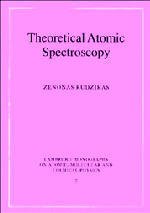Description
Theoretical Atomic Spectroscopy
Cambridge Monographs on Atomic, Molecular and Chemical Physics Series
Author: Rudzikas Zenonas
Graduate-level text and research reference presenting a complete guide to the theory of modern atomic spectroscopy.
Language: English
Subject for Theoretical Atomic Spectroscopy:
Approximative price 62.49 €
Subject to availability at the publisher.
Add to cart
Publication date: 07-2007
456 p. · 16.9x24.3 cm · Paperback
456 p. · 16.9x24.3 cm · Paperback
Description
/li>Contents
/li>
This monograph presents a complete guide to the theory of modern spectroscopy of atoms. Atomic spectroscopy continues to be one of the most important subjects of contemporary physics. The book describes the contemporary state of the theory of many-electron atoms and ions, the peculiarities of their structure and spectra, the processes of their interaction with radiation, and some of the applications of atomic spectroscopy. It contains a large number of new results, which have been published mainly in Russian and are therefore almost unknown to western scientists. Primarily a reference for researchers and graduate students in atomic physics and physical chemistry, this work will also be of value to physicists and chemists in other areas who use spectroscopy in their work.
Preface; Introduction; Part I. Energy Spectrum of Many-electron Atom. Radiative and Autoionizing Transitions (Initial Formulas): 1. Non-relativistic atomic Hamiltonian and relativistic corrections; 2. Relativistic atomic Hamiltonian. New wave function; 3. Perturbation theory for the energy of an atom; 4. Radiative and autoionizing electronic transitions. Generalized expressions for electric multipole (Ek) transition operators; Part II. Foundations of the Angular Momentum Theory. Graphical Methods: 5. Angular momentum and tensorial algebra; 6. Main quantities of angular momentum theory; 7. Angular momentum theory for relativistic case; 8. Graphical methods: their generalization for perturbation theory; Part III. Description of Complex Electronic Configurations: 9. Non-relativistic and relativistic cases of a shell of equivalent electrons; 10. Two and more shells of equivalent electrons; 11. Classification of energy levels; 12. Relations between various coupling schemes; Part IV. Second-quantization in the Theory of an Atom: Quasispin and Isospin: 13. Second-quantization and irreducible tensorial sets; 14. Operators and matrix elements in second-quantization representation; 15. Quasispin for a shell of equivalent electrons; 16. Algebraic expressions for coefficients of fractional parentage (CFP); 17. Tensorial properties and quasispin of complex configurations; 18. Isospin in the theory of an atom; Part V. Matrix Elements of the Energy Operator: 19. The energy of a shell of equivalent electrons; 20. Interaction energy of two shells in LS coupling; 21. Semi-empirical methods of calculation of the energy spectra; 22. Hyperfine structure of the energy spectra, isotopic and Lamb shift; 23. Quasispin and isospin for relativistic matrix elements; Part VI. Electric and Magnetic Multipole Transitions: 24. General expressions for electric (Ek) and magnetic (Mk) multipole radiation quantities; 25. Non relativistic matrix elements of the Ek-transitions; 26. Relativistic matrix elements of Ek-transitions; 27. Mk-transitions. Particular cases of E2- and M1-transitions; Part VII. Calculation of Energy Spectra and Electronic Transitions in the Case of Complex Configurations: 28. Methods of determination of radial orbitals; 29. Correlation effects. Perturbation theory; 30. The role of gauge dependence, relativistic and correlation effects in electronic transitions; 31. Peculiarities of the structure and spectra of highly ionized atoms; 32. Global methods in the theory of many-electron atoms; 33. Peculiarities of configurations with vacancies in inner shells; Epilogue; References; Index.
© 2024 LAVOISIER S.A.S.



